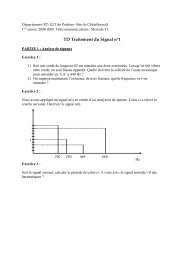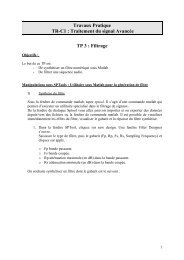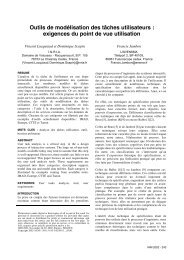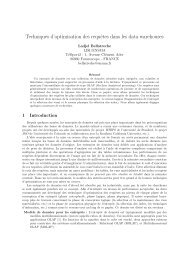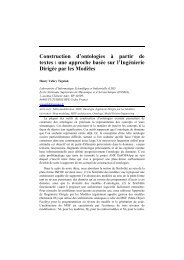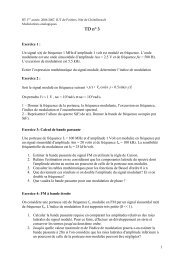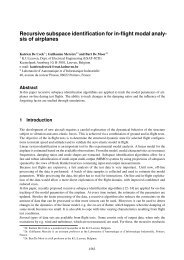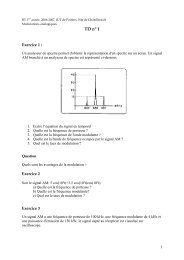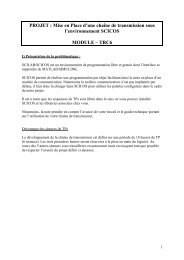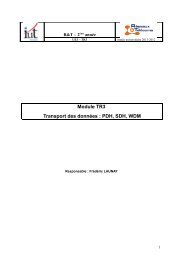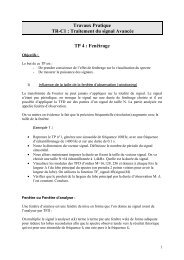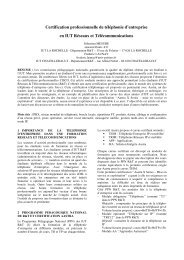Continuity and Approximability of Response Time Bounds - LIAS
Continuity and Approximability of Response Time Bounds - LIAS
Continuity and Approximability of Response Time Bounds - LIAS
You also want an ePaper? Increase the reach of your titles
YUMPU automatically turns print PDFs into web optimized ePapers that Google loves.
19th Euromicro Conference on Real-<strong>Time</strong> Systems (ECRTS 2007), Work-in-Progress track<br />
<strong>Continuity</strong> <strong>and</strong> <strong>Approximability</strong> <strong>of</strong> <strong>Response</strong> <strong>Time</strong> <strong>Bounds</strong><br />
S.K Baruah<br />
Department <strong>of</strong> Computer Science, University <strong>of</strong> North Carolina, Chapel Hill, USA.<br />
E. Bini<br />
Scuola Superiore Sant’Anna, Pisa, Italy<br />
T.H.C. Nguyen, P. Richard<br />
Laboratoire d’Informatique Scientifique et Industrielle, Ensma, Poitiers,France.<br />
Abstract<br />
Since worst-case response times must be determined<br />
repeatedly during the interactive design <strong>of</strong><br />
real-time application systems, repeated exact computation<br />
<strong>of</strong> such response times would slow down<br />
the design process considerably. In this research,<br />
we identify three desirable properties <strong>of</strong> estimates<br />
<strong>of</strong> the exact response times: continuity with respect<br />
to system parameters; efficient computability; <strong>and</strong><br />
approximability. We demonstrate that a recentlyproposed<br />
technique for estimating the worst-case<br />
response time <strong>of</strong> sporadic task systems that are<br />
scheduled using static priority upon a preemptive<br />
uniprocessor possesses these properties.<br />
1. Introduction <strong>and</strong> Motivation<br />
In preemptive uniprocessor sporadic task systems<br />
that are scheduled according to static priorities,<br />
the well-known technique <strong>of</strong> response-time<br />
analysis (RTA) allows for the exact computation<br />
<strong>of</strong> the worst-case response time <strong>of</strong> each task in<br />
time pseudo-polynomial in the representation <strong>of</strong><br />
the task system. Consider a system <strong>of</strong> n tasks<br />
τ 1 , τ 2 , . . . , τ n , with the i’th task τ i characterized<br />
by a worst-case execution time C i <strong>and</strong> a minimum<br />
inter-arrival separation parameter T i , <strong>and</strong> with the<br />
additional constraint that each task τ i have a worstcase<br />
response time ≤ T i . Without loss <strong>of</strong> generality,<br />
assume that the tasks are indexed in decreasing<br />
order <strong>of</strong> priority. Let R i denote the the worst-case<br />
response time <strong>of</strong> τ i ; RTA asserts that the the value<br />
<strong>of</strong> R i is equal to the smallest t satisfying the following<br />
equality:<br />
t = C i + ∑ ⌈ ⌉ t<br />
C j (1)<br />
T<br />
j
ing them. Nevertheless, we believe that there is<br />
some benefit to studying upper bounds on worstcase<br />
response times that do not suffer such discontinuities<br />
with system parameters. If we were to<br />
use these continuous upper bounds (rather than the<br />
discontinuous exact bounds) during the system design<br />
process, then we would know that neighboring<br />
points in the design state space would have similar<br />
response time bounds. (Thus for example if we<br />
were at a point in the design state space where every<br />
task except one had its response-time bound well<br />
within acceptable limits, we could safely consider<br />
making small changes to the task parameters in order<br />
to search for neighboring points in the design<br />
state space in which the response time bound <strong>of</strong> the<br />
non-compliant task is decreased, without needing<br />
to worry that the response time <strong>of</strong> some currently<br />
compliant task would increase by a large amount.)<br />
Any such continuous upper bound on responsetime<br />
is necessarily not tight (since as stated above,<br />
the property <strong>of</strong> worst-case response-time is itself<br />
not continuous in the system parameters). In other<br />
words, by choosing a continuous upper bound we<br />
would be trading <strong>of</strong>f accuracy for continuity: it is<br />
desirable that this loss <strong>of</strong> continuity be quantified in<br />
some manner in order that the system designer may<br />
determine whether the loss <strong>of</strong> accuracy is worth the<br />
benefits that continuous bounds provide to the system<br />
design process.<br />
An additional requirement on such bounds, if<br />
they are to be used repeatedly during an interactive<br />
design process, is that they be efficiently computable,<br />
preferably in fast polynomial time. (Efficient<br />
computation could be another reason for preferring<br />
to use some approximation – continuous or<br />
not – rather than the exact worst-case responsetime<br />
<strong>of</strong> Equation 1, which has a pseudo-polynomial<br />
computation time.)<br />
To summarize the points made above: we are<br />
seeking upper bounds on the worst-case response<br />
time that are continuous functions <strong>of</strong> system parameters;<br />
in addition, we would like these bounds to<br />
be efficiently computable, <strong>and</strong> to have quantifiable<br />
deviation from the exact bounds.<br />
2. Approximation results<br />
The theory <strong>of</strong> approximation algorithms for<br />
combinatorial optimization problem can be used<br />
to quantify the performance guarantee <strong>of</strong> response<br />
time bounds. The performance guarantee <strong>of</strong> an algorithm<br />
is analyzed through its approximation ratio.<br />
Let a be the value obtained by an algorithm<br />
A that solves a minimization problem, <strong>and</strong> opt be<br />
the exact (i.e., minimum) value; algorithm A has an<br />
approximation ratio <strong>of</strong> c, where c ≤ 1, if <strong>and</strong> only<br />
if opt ≤ a ≤ c × opt for all inputs to the algorithm<br />
A. (If such a c does not exist, then algorithm A is<br />
said to have no approximation ratio — this means<br />
that the bound computed by A can be very far away<br />
from the optimal one.) If A is a polynomial time algorithm<br />
<strong>and</strong> has a bounded performance guarantee,<br />
then it is called an approximation algorithm.<br />
An efficiently-computable continuous upper<br />
bound on response time is easily derived from the<br />
technique <strong>of</strong> [3] (this technique was originally proposed<br />
in [3] for computing a lower bound):<br />
∑<br />
j
<strong>and</strong> τ 3 = (ɛ, 2K + ɛ), where ɛ is an arbitrarily<br />
small positive number <strong>and</strong> K is an arbitrary number<br />
greater than ɛ. The utilization U 1 +U 2 +U 3 is 1 <strong>and</strong><br />
since tasks have all periods equal to 2K + ɛ, then<br />
R 3 = 2K +ɛ using the Rate Monotonic scheduling<br />
policy. The upper bound is:<br />
ub i = ɛ + 2K(1 − K<br />
2K+ɛ )<br />
1 − 2K<br />
2K+ɛ<br />
=<br />
ɛ(2K + ɛ) + 2K(2K + ɛ − K)<br />
2K + ɛ − 2K<br />
=<br />
(2K + ɛ)ɛ + 2K(K + ɛ)<br />
ɛ<br />
= 4K + ɛ + 2K2<br />
ɛ<br />
Thus,<br />
(<br />
)<br />
lim ub i = lim 4K + ɛ + 2K2<br />
ɛ→0 ɛ→0 ɛ<br />
<strong>and</strong> the theorem is proved.<br />
= ∞<br />
3. Resource Augmentation analysis<br />
The results in Section 2 reveal that the upper<br />
bound ub i on response-time <strong>of</strong> [1] does not <strong>of</strong>fer<br />
any quantifiable performance guarantee, according<br />
to the conventional approximation ratio measure<br />
that is used in optimization theory. However, an<br />
alternative approach towards approximate analysis<br />
is sometimes used in real-time scheduling theory –<br />
the technique <strong>of</strong> resource augmentation. In this<br />
technique, the performance <strong>of</strong> the algorithm under<br />
analysis is compared with that <strong>of</strong> an optimal algorithm<br />
that runs on a slower processor. In this<br />
section, we apply this resource augmentation technique<br />
to quantify the deviation <strong>of</strong> ub i from optimality.<br />
In obtaining upper bounds to the worst-case response<br />
time, the first step is typically to replace the<br />
expression within the ceiling function — i.e., the<br />
expression (⌈t/T j ⌉C j ) — in the exact computation<br />
<strong>of</strong> the worst-case response time (Equation 1) by a<br />
linear approximation LA(τ j , t). The approximation<br />
introduced in [1] is as follows:<br />
LA(τ j , t) = U j × t + C j (1 − U j ) (4)<br />
(See [1] for details, <strong>and</strong> a pro<strong>of</strong> <strong>of</strong> correctness.)<br />
Now it would be nice if<br />
C j<br />
⌈ t<br />
T j<br />
⌉<br />
≤ LA(τ j , t)<br />
were to hold for all t ≥ 0; if this were the case,<br />
the correctness <strong>of</strong> ub i — the fact that it is indeed<br />
an upper bound on the exact worst-case response<br />
time — would follow immediately. Unfortunately,<br />
however, this inequality is not true for all t; indeed,<br />
values <strong>of</strong> t arbitrarily close to 0 bear witness ⌈ to⌉ its<br />
falsity. However, it can be shown 1 t<br />
that C j T j<br />
≤<br />
LA(τ j , t) does indeed hold at all those values <strong>of</strong> t<br />
which matter:<br />
Lemme 1 For all values <strong>of</strong> t that are potential values<br />
<strong>of</strong> R i ,<br />
C j<br />
⌈ t<br />
T j<br />
⌉<br />
≤ LA(τ j , t)<br />
An upper bound on amount by which LA(τ j , t) deviates<br />
from its exact value can also be shown:<br />
Lemme 2 For all values <strong>of</strong> t that are potential values<br />
<strong>of</strong> R i ,<br />
LA(τ j , t) ≤ 2 × C j<br />
⌈ t<br />
T j<br />
⌉<br />
It can be shown that the bound ub i (as defined in<br />
Equation 3 above) is equal to the smallest value <strong>of</strong><br />
t satisfying the following inequality:<br />
t = C j + ∑ j
above, it must be the case that for all t < ub i<br />
t < C j + ∑ j



